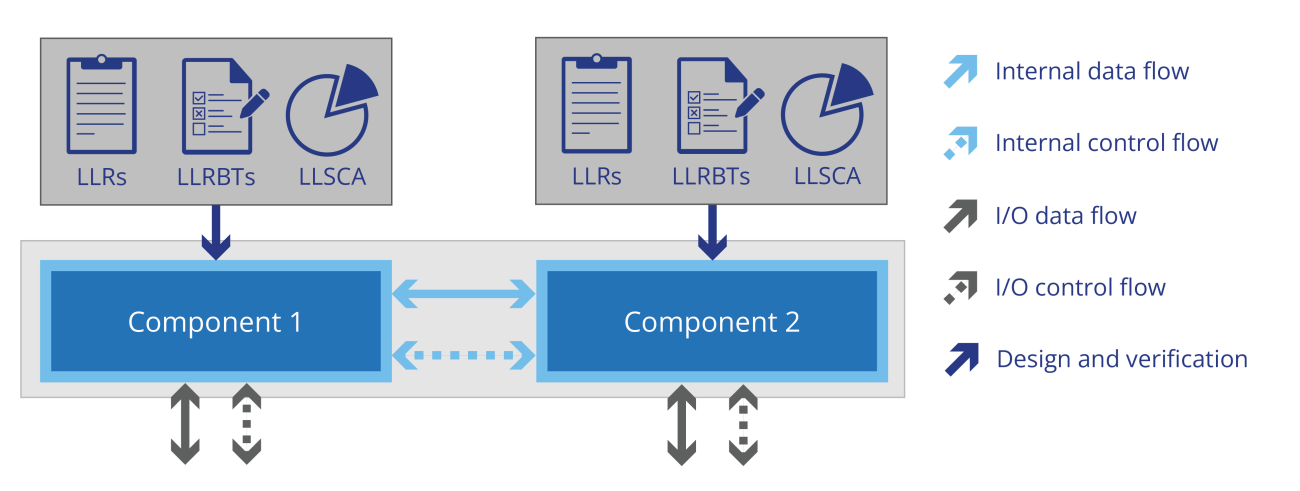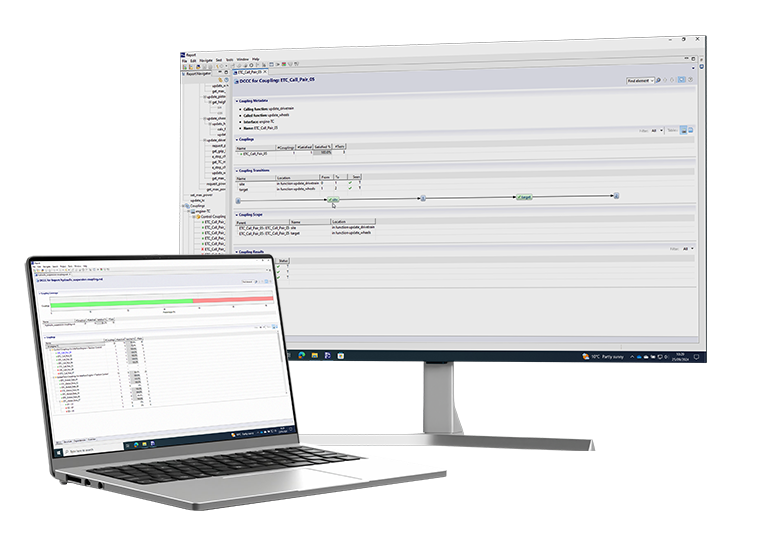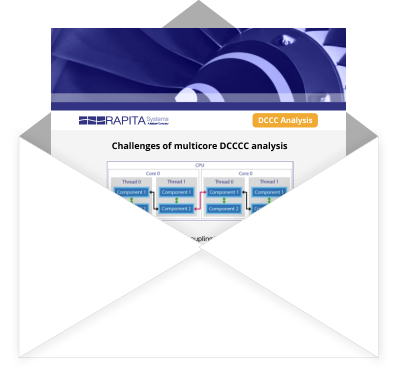"Data coupling" and "control coupling" (collectively “DCCC”) concern the way software components interact with each other in an integrated system to perform a higher-level function. Understanding software DCCC and analyzing DCCC coverage during integration testing can help reduce development costs and mitigate risks, and DCCC analysis is required for DO-178C certification of critical avionics. Rapita Systems is developing RapiCoupling, an automation solution designed to meet the complexities of DCCC analysis for modern DO-178C software.
This is our third blog on Data Coupling and Control Coupling analysis for DO-178C software. In our previous blogs, we gave an introduction to DCCC for DO-178C and discussed why there’s no standard approach to DCCC analysis. In this blog, we’ll explore the role of components in DCCC analysis, and how DCCC supports the decomposition of software functionality into components.
What is a software component?
DO-178C describes both Data Coupling and Control Coupling relative to the idea of a “code component”: Analysis to confirm that the requirements-based testing has exercised the data and control coupling between code components [DO-178C 6.4.4.2 c)]. But what is a code component?
In its Glossary, DO-178C defines a component as “a ‘self-contained part, combination of parts, subassemblies, or units that performs a distinct function of a system’”. The term component is used in a variety of ways throughout the standard. However, it is generally accepted that the definition of software (or code) component for DCCC purposes follows directly from the design objective. During design, the software is decomposed into components and low-level requirements are documented to specify what each component has to do. The interfaces between components are captured by the software architecture, including information such as data dictionaries, which should make explicit the intended control and data flow over each interface.
The links between the design process, the notion of software component, and DCCC, are implied by the descriptions in the standard, for example: “Interfaces between software components, in the form of data flow and control flow, should be designed to be consistent between components” [DO-178C, 5.2.2 d)]. Based on DO-178C’s definitions and terminology, we can therefore view software components as the following:
- The way that low-level requirements (LLRs) are partitioned into groups
- What defines, along with the architecture, the input stimuli and output responses over which those requirements are expressed
- What defines, along with the code, the software functions that low-level requirements-based testing (LLRBTs) and low-level structural coverage analysis (SCA, comprising MC/DC, decision, and statement coverage) will apply to.

Note that superficial notions of what constitutes components, for example that each source file comprises a component, are only valid if the system has been developed so there is a one-to-one mapping between source files and components specified in the software design. This is by no means always the case.
How does DCCC support the decomposition of software into components?
DCCC analysis serves an important role in supporting the decomposition of software into components and helping to establish the correctness and safety of an airborne system.
Decomposition of software functionality into components is the mechanism provided by DO-178C for managing complexity. By decomposing functionality into components, we can develop components separately, verify their function according to low-level requirements and verify the sufficiency of testing using low-level structural coverage analysis (MC/DC, decision, and statement coverage).
However, to be able to decompose software function confidently, we need a robust process for verifying that the decomposition is correct, that we haven’t made mistakes defining what our code components need to do, and we haven’t made invalid assumptions about how they will behave collectively when we connect them together. In other words, we need to know that assembling sub-components in the way we have, based on how we’ve specified them, results in a system that faithfully implements the intent of the design.
DCCC analysis supports this process. While requirements-based integration testing provides evidence that the integrated software meets its high-level requirements, DCCC analysis can help demonstrate the sufficiency of integration testing, and validate that high-level requirements are complete.

How do components impact DCCC analysis?
Components have a huge impact on DCCC analysis. CAST-19 defined both Data Coupling and Control Coupling as relating to interactions between components, and this is consistent with the role of DCCC analysis in helping us provide a sufficiency metric for integration testing (integration of components).
What constitutes an acceptable DCCC analysis argument, and the steps you need to go through producing it, are topics of lively debate. The consensus, however (supported by the CAST-19 definitions), is that interfaces between components are the primary focus for the activity, i.e. for DCCC analysis to be “complete”, all of the ways that components can affect one another need to be verified.
Guidance about what that should involve is patchy, but some common considerations include:
- Have all the significant ways each component can impact another component’s flow of control been observed?
- Have all the significant ways data can be supplied and consumed by components been observed?
- Have all interfaces been confirmed to be working as intended?
- Have all the significant ways inputs/outputs can be presented to/generated by the system been observed to be correct?
There is some disagreement about whether all of the above can be achieved based on properties derived directly from the code, or whether this requires deeper consideration of both the code and other artifacts produced as part of the development process (See our previous blog on the “two schools of thought”).
Either way, though, components play a crucial role in defining DCCC analysis criteria. The couplings we should observe to satisfy ourselves (and our certification authority) that we’ve done sufficient integration testing are based on interfaces, and ultimately, components.
 Preview
Preview
An innovative new approach for DCCC Analysis

- Data coupling and control coupling analysis for DO-178C
- Configurable definition of components, interfaces and couplings
- Process guidance to help define couplings for your project
Conclusion
Components are an important concept in DCCC analysis. Defined by the software design, they help us identify the interfaces in the system across which couplings arise, and are used as the basis for defining DCCC analysis goals. DCCC analysis serves an important role in DO-178C projects by supporting the decomposition of software function into components.
In our next blog, we’ll take a closer look at control coupling.
Wanting to learn more about DCCC? Check out our full blog series or download our DCCC Solutions for DO-178C Product brief.
Want to stay up to date with DCCC content? Sign up to our mailing list below.


 Rapita System Announces New Distribution Partnership with COONTEC
Rapita System Announces New Distribution Partnership with COONTEC
 Rapita partners with Asterios Technologies to deliver solutions in multicore certification
Rapita partners with Asterios Technologies to deliver solutions in multicore certification
 SAIF Autonomy to use RVS to verify their groundbreaking AI platform
SAIF Autonomy to use RVS to verify their groundbreaking AI platform
 RVS gets a new timing analysis engine
RVS gets a new timing analysis engine
 How to measure stack usage through stack painting with RapiTest
How to measure stack usage through stack painting with RapiTest
 What does AMACC Rev B mean for multicore certification?
What does AMACC Rev B mean for multicore certification?
 How emulation can reduce avionics verification costs: Sim68020
How emulation can reduce avionics verification costs: Sim68020
 How to achieve multicore DO-178C certification with Rapita Systems
How to achieve multicore DO-178C certification with Rapita Systems
 How to achieve DO-178C certification with Rapita Systems
How to achieve DO-178C certification with Rapita Systems
 Certifying Unmanned Aircraft Systems
Certifying Unmanned Aircraft Systems
 DO-278A Guidance: Introduction to RTCA DO-278 approval
DO-278A Guidance: Introduction to RTCA DO-278 approval
 Avionics Certification Q&A: CERT TALK (with Consunova and Visure)
Avionics Certification Q&A: CERT TALK (with Consunova and Visure)















